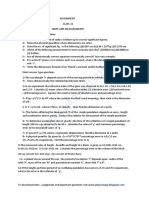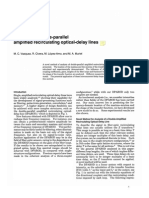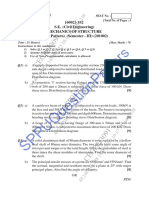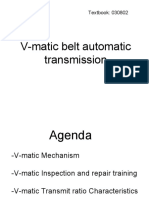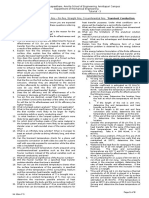Exercises
Exercises
Uploaded by
Sunil Kumar SinghCopyright:
Available Formats
Exercises
Exercises
Uploaded by
Sunil Kumar SinghOriginal Description:
Original Title
Copyright
Available Formats
Share this document
Did you find this document useful?
Is this content inappropriate?
Copyright:
Available Formats
Exercises
Exercises
Uploaded by
Sunil Kumar SinghCopyright:
Available Formats
Turbulence Prof. E.G.
Tulapurkara
Chapter-1
Chapter 1
Exercises
Exercises
1) Answer the following.
2) Define the terms : time average , space average, phase average and ensemble
average.
b) Define the term probability density function (PDF). What properties should a PDF
satisfy? Verify that the following PDF satisfies them.
P(U) = 0 ; U < -3
=
1
16
3+U2 ; -3 U -1
1
6 - 2U ; -1 U 1
2
=
16
1
3 -U ; -1 U 3
2
=
16
=0;U>3
c) Turbulence is a continuum phenomenon – explain.
d) Explain the term central moments. Show that the first central moment is zero for a
stationary random quantity. Give expressions for the second, third and fourth central
moments. In light of these define skewness (S) and kurtosis (K). What are the values of
‘S’ and ‘K’ for a Gaussian distribution?
e) Sketch a typical autocorrelation function and define integral time scale and Taylor
micro scale E using this curve. What is an alternate way to obtain an accurate
estimate of E ?
f) What is Taylor’s hypothesis and how does it help in obtaining length scale from time
scale?
g) Following ten readings are a sample of a turbulent signal. Obtain the quantity
u2 ν
from the data.
U
3
Dept. of Aerospace Engg., Indian Institute of Technology, Madras 1
Turbulence Prof. E.G. Tulapurkara
Chapter-1
U(m/s) 10.2 9.8 9.6 9.0 11.0 11.2 11.05 10.75 10.6 10.0
V(m/s) 1.0 1.5 0.0 0.7 0.6 0.2 1.6 0.8 0.25 0.5
(Hint : Obtain U,V,u, and proceed).
u2 ν
[Ans : = 1.852 x 10-5 ]
U
3
h) Explain the concept of energy cascade and relationship between turbulent kinetic
energy produced and the energy dissipated.
i) Viscosity decides the scale at which dissipation takes place but not the amount of
dissipation. Explain?
j) Briefly explain the arguments leading to Kolmogorov length scale ( η d ). Using
dimensional analysis show that
d = / ε ; ud ε
1/2 1/4
Where, ε = rate of dissipation of turbulent kinetic energy and = kinematic viscosity.
Further show that d / TE = RL11
-1/2 -1/4
and ud / Vt = RL11 , Where RL11 is Reynolds number,
based on the length scale of larger eddies (L11) and their velocity scale (Vt).
k) Define conditional sampling and briefly explain as to how it is used in understanding
turbulent flows.
l) Briefly explain the phenomenon of intermittency. In a turbulent signal taken over 100
ms, the flow was observed to be non-turbulent during intervals of 14 to 22 ms, 30 to 35
ms, 41 to 47 ms, 53 to 62 ms, 77 to 82 ms and 91 to 96 ms. Obtain the value of the
intermittency factor.
[ Ans : = 0.62 ].
2) Reference 1.67 presents data on turbulence quantities in the wake of a circular
cylinder of diameter (d). See Fig.1.2b which shows wake of an aerofoil. Following
values are obtained at the center line at a location where x/d = 420.
2
u1
u = 0.1m / s ,
2
= 18 s , ε = 0.109 m / s ,external velocity =Ue = 6.7 m/s,
-1 2 3
1
1
x
= 14×10-6 m/s2 . Obtain the following.
Dept. of Aerospace Engg., Indian Institute of Technology, Madras 2
Turbulence Prof. E.G. Tulapurkara
Chapter-1
(i) Longitudinal Taylor micro scale ( λ )
2
u
(ii) Isotropic dissipation ( i ) given by ε i = 15 1 . Comment on the
x1
difference between ε and ε i .
[Ans : λ = 5.55×10-3 ; i = 0.06801 m2 / s3 . ]
Comment : In this case ε i is 62.4 % of ε . This could cause error in estimate of
Kolmogrov scales ηd , d & ud . Noting that ηd , is proportional to ε-1/4 , the use of ε i
would result in about 13 % over-estimate of ηd .
3) Reference 1.67 also presents the following data on variation of ε across the upper
half of the wake. Note : y = 0 indicates centre line of the wake.
y(mm) 0 2.48 4.96 7.44 9.92 12.88 19.84 24.8
ε (m2/s3) 0.1160 0.1183 0.1271 0.1190 0.1134 0.0804 0.0383 0.00979
Obtain variation of η d across the wake.
[Ans :
y(mm) 0 2.48 4.96 7.44 9.92 12.88 19.84 24.8
ηd 0.759 0.755 0.742 0.754 0.763 0.831 1.001 1.407
(mm)
Remark : Sometimes, one may mention representative value of ηd in a particular
flow, based on appropriate value of ‘L’ and Vt. However, as shown above ‘ ε ‘
varies across the flow and so does ηd . In chapter 4 variations of ε across some
other flows are presented ].
Dept. of Aerospace Engg., Indian Institute of Technology, Madras 3
You might also like
- Numerical Simulations and Laboratory Measurements in Hydraulic JuNo ratings yetNumerical Simulations and Laboratory Measurements in Hydraulic Ju9 pages
- Appropriate boundary conditions for computational wind engineering models using the k-ε turbulence modelNo ratings yetAppropriate boundary conditions for computational wind engineering models using the k-ε turbulence model9 pages
- Please Prepare Your Questions and Answers by Using The Following GuidelinesNo ratings yetPlease Prepare Your Questions and Answers by Using The Following Guidelines17 pages
- (WFD Paper) 22 CMSIM 2012 Dubey Kapila 1 241-256No ratings yet(WFD Paper) 22 CMSIM 2012 Dubey Kapila 1 241-25616 pages
- 2021 Fall semester General Physics 2 Final exam session 2No ratings yet2021 Fall semester General Physics 2 Final exam session 25 pages
- J. R. Herring Et Al - Statistical and Dynamical Questions in Strati Ed TurbulenceNo ratings yetJ. R. Herring Et Al - Statistical and Dynamical Questions in Strati Ed Turbulence23 pages
- Quantum Physics Problem Sheet 1: (Answers Available From Monday 13th February)No ratings yetQuantum Physics Problem Sheet 1: (Answers Available From Monday 13th February)4 pages
- Ultrasonic Echography A-Scan and Ultrasonic B-Scan: Universiti Teknologi Mara (Uitm)No ratings yetUltrasonic Echography A-Scan and Ultrasonic B-Scan: Universiti Teknologi Mara (Uitm)10 pages
- Step-5-Luis Andres Ramos - Grupo 203058-46No ratings yetStep-5-Luis Andres Ramos - Grupo 203058-4612 pages
- Actuators: Getting Started With Peas-Based Flapping-Wing Mechanisms For Micro Aerial SystemsNo ratings yetActuators: Getting Started With Peas-Based Flapping-Wing Mechanisms For Micro Aerial Systems17 pages
- 1181 WIND FARM LAYOUT OPTIMIZATION WindFLO-User-Guide VERSION 1 Sohail R Reddy Del Doc 1179No ratings yet1181 WIND FARM LAYOUT OPTIMIZATION WindFLO-User-Guide VERSION 1 Sohail R Reddy Del Doc 117914 pages
- Atmosphere: Comparison of Different Techniques To Calculate Properties of Atmospheric Turbulence From Low-Resolution DataNo ratings yetAtmosphere: Comparison of Different Techniques To Calculate Properties of Atmospheric Turbulence From Low-Resolution Data22 pages
- Implementation of A Moments Model in Openfoam For Polydispersed Multiphase FlowsNo ratings yetImplementation of A Moments Model in Openfoam For Polydispersed Multiphase Flows10 pages
- Derivation and Analysis of Some Wave EquationsNo ratings yetDerivation and Analysis of Some Wave Equations19 pages
- Determination of Wave Length of Laser Radiation by Interference. Jung MethodNo ratings yetDetermination of Wave Length of Laser Radiation by Interference. Jung Method12 pages
- IIT-JEE 2005 Mains Paper With Answer KeyNo ratings yetIIT-JEE 2005 Mains Paper With Answer Key12 pages
- Damping of Materials and Members in Structures100% (1)Damping of Materials and Members in Structures16 pages
- Course: Physics (PH101) : Duration: 3 WeeksNo ratings yetCourse: Physics (PH101) : Duration: 3 Weeks2 pages
- Smooth Particle Hydrodynamics: Some ResultsNo ratings yetSmooth Particle Hydrodynamics: Some Results13 pages
- Numerical Study On The Effect of Mooring Line Stiffness On Hydrodynamic Performance of Pontoon-Type Floating BreakwaterNo ratings yetNumerical Study On The Effect of Mooring Line Stiffness On Hydrodynamic Performance of Pontoon-Type Floating Breakwater6 pages
- Nonlinear Control of a MEMS Optical Switch_Part2No ratings yetNonlinear Control of a MEMS Optical Switch_Part21 page
- Student Solutions Manual to Accompany Economic Dynamics in Discrete Time, secondeditionFrom EverandStudent Solutions Manual to Accompany Economic Dynamics in Discrete Time, secondedition4.5/5 (2)
- Be Civil Engineering Semester 3 2023 May Mechanics of Structure Mos Pattern 2019No ratings yetBe Civil Engineering Semester 3 2023 May Mechanics of Structure Mos Pattern 20193 pages
- V-Matic Belt Automatic Transmission: Textbook: 030802No ratings yetV-Matic Belt Automatic Transmission: Textbook: 03080228 pages
- A Grima Modelling of Bulk Material Flow PropertiesNo ratings yetA Grima Modelling of Bulk Material Flow Properties342 pages
- Group 2-Sound Absorbtion, Reflection and Transmission, Mechanism of Sound Absorbtion and Reverberation of TimeNo ratings yetGroup 2-Sound Absorbtion, Reflection and Transmission, Mechanism of Sound Absorbtion and Reverberation of Time68 pages
- Free Vibration of Single-Degree-Of-freedom SystemsNo ratings yetFree Vibration of Single-Degree-Of-freedom Systems7 pages
- Unstiffened Cylinders EN 13445-3 - 8.5.2 PDFNo ratings yetUnstiffened Cylinders EN 13445-3 - 8.5.2 PDF4 pages
- Attachment 3 - Methodology of Wave Spectral Fatigue AnalysisNo ratings yetAttachment 3 - Methodology of Wave Spectral Fatigue Analysis2 pages
- Aerodynamic Characteristics of Naca 0012 Airfoil by CFD AnalysisNo ratings yetAerodynamic Characteristics of Naca 0012 Airfoil by CFD Analysis8 pages
- Chapter 4 - Analysis of Structures Using Strain - Energy MethodNo ratings yetChapter 4 - Analysis of Structures Using Strain - Energy Method10 pages
- Applied Asymptotic Methods in Nonlinear OscillationsNo ratings yetApplied Asymptotic Methods in Nonlinear Oscillations351 pages
- 2004 - Advanced Soil Mechanics - MIT PDFNo ratings yet2004 - Advanced Soil Mechanics - MIT PDF259 pages





















